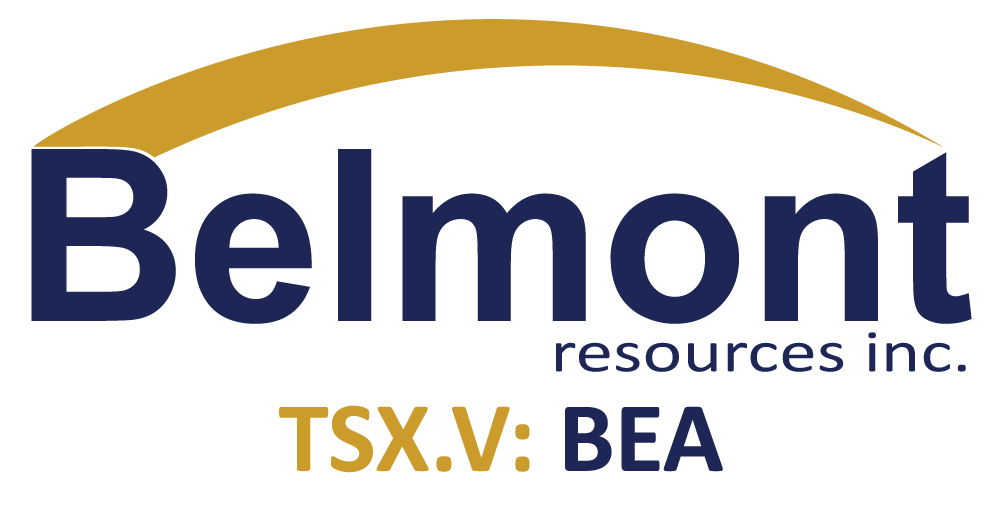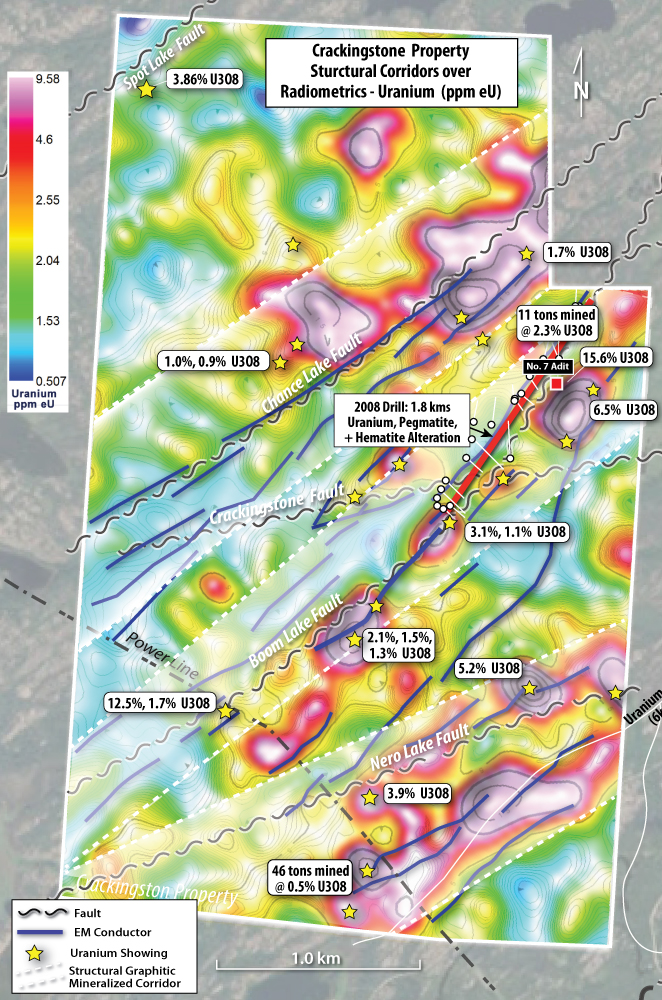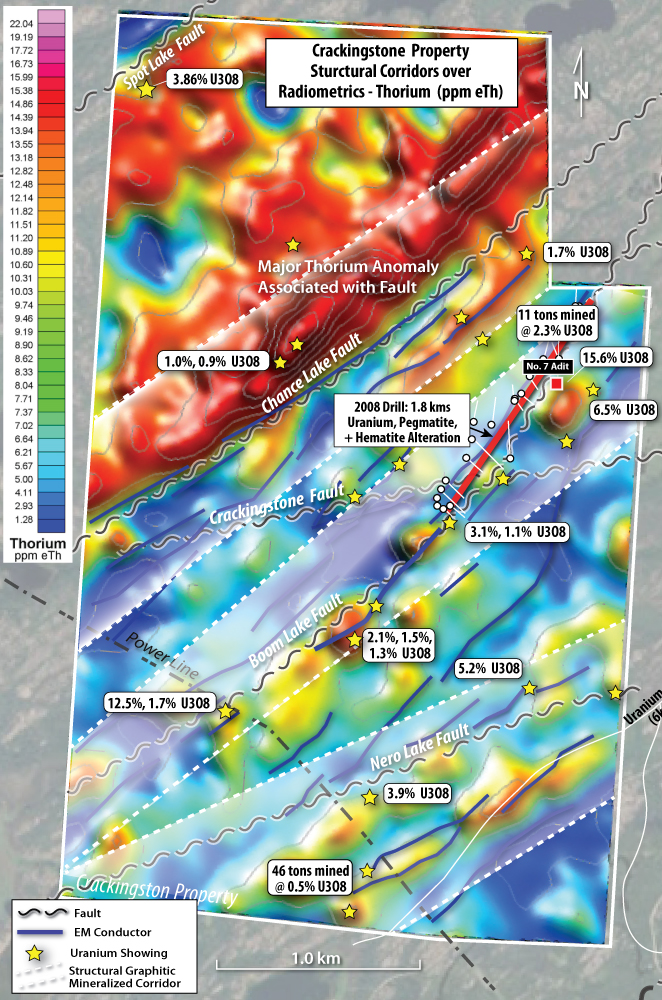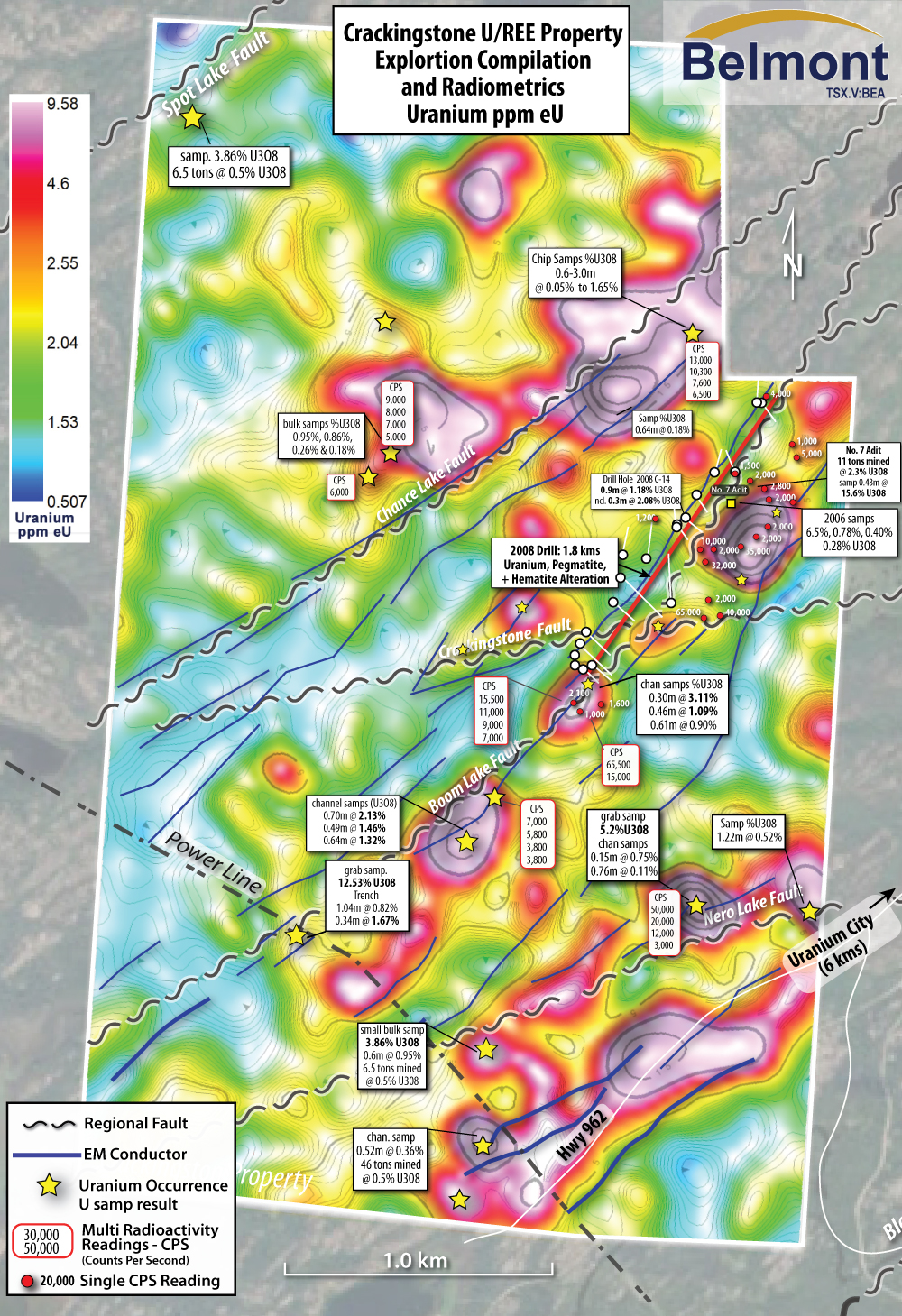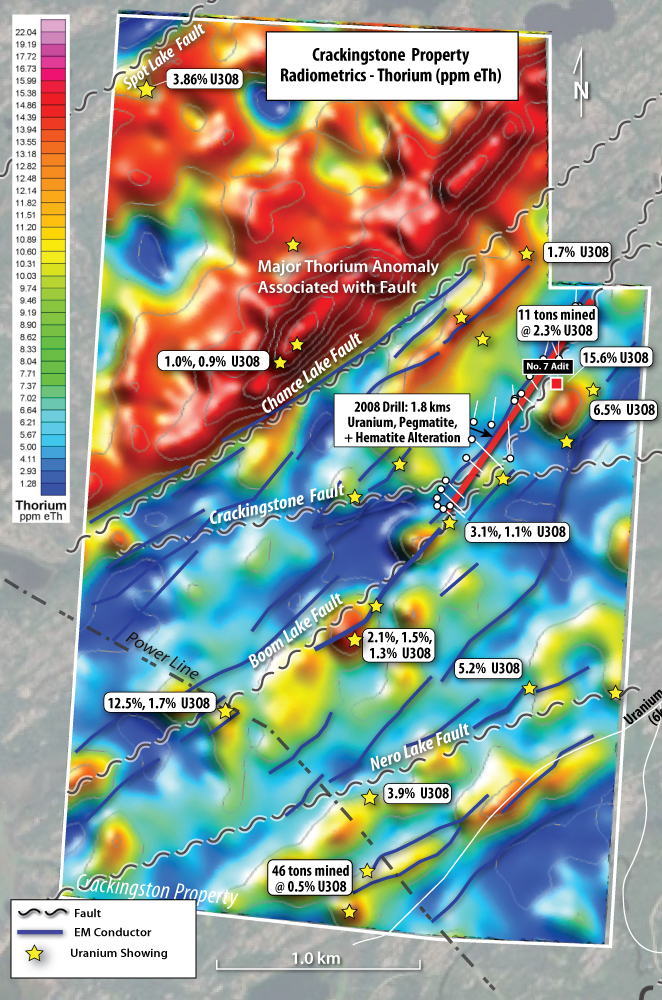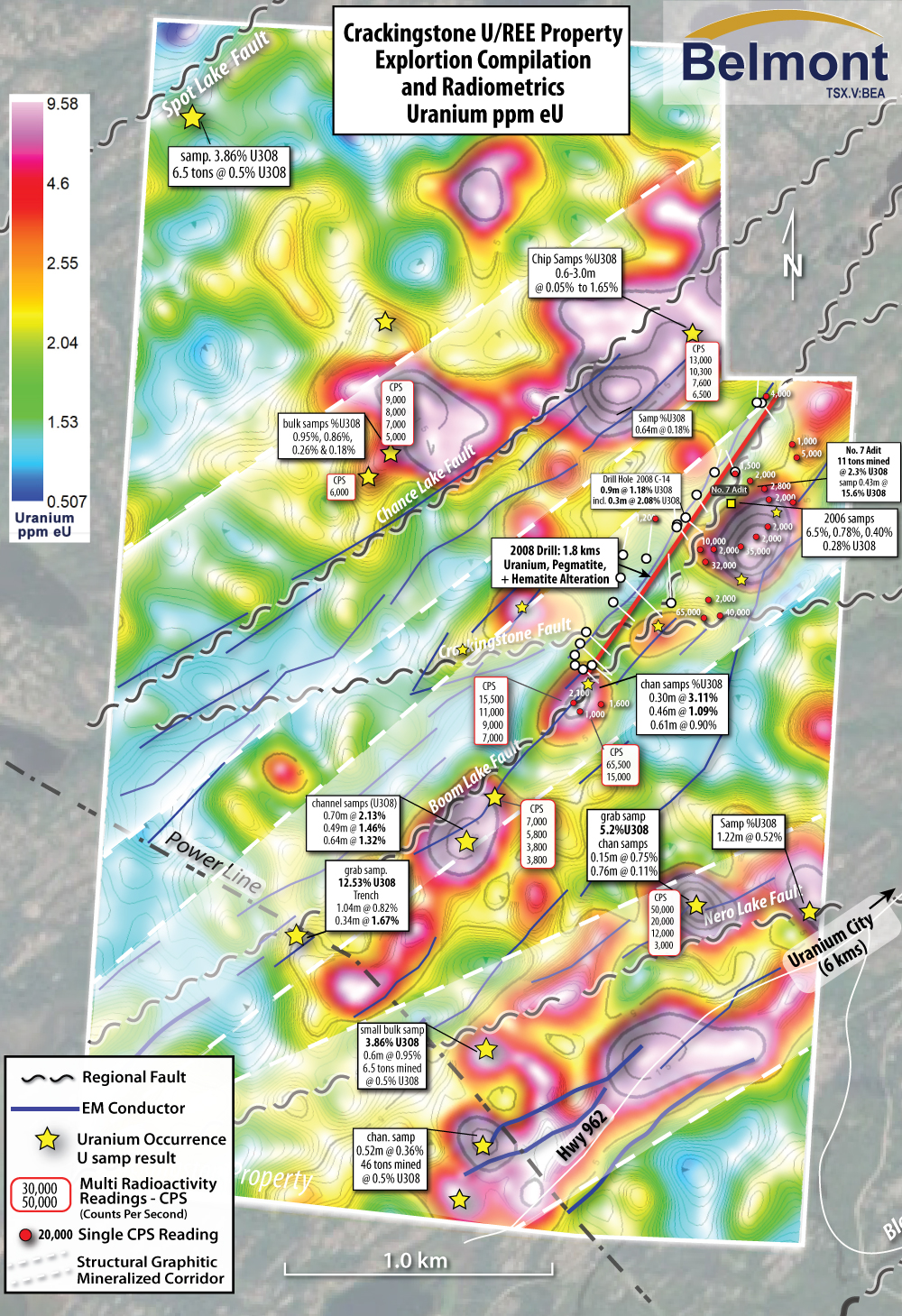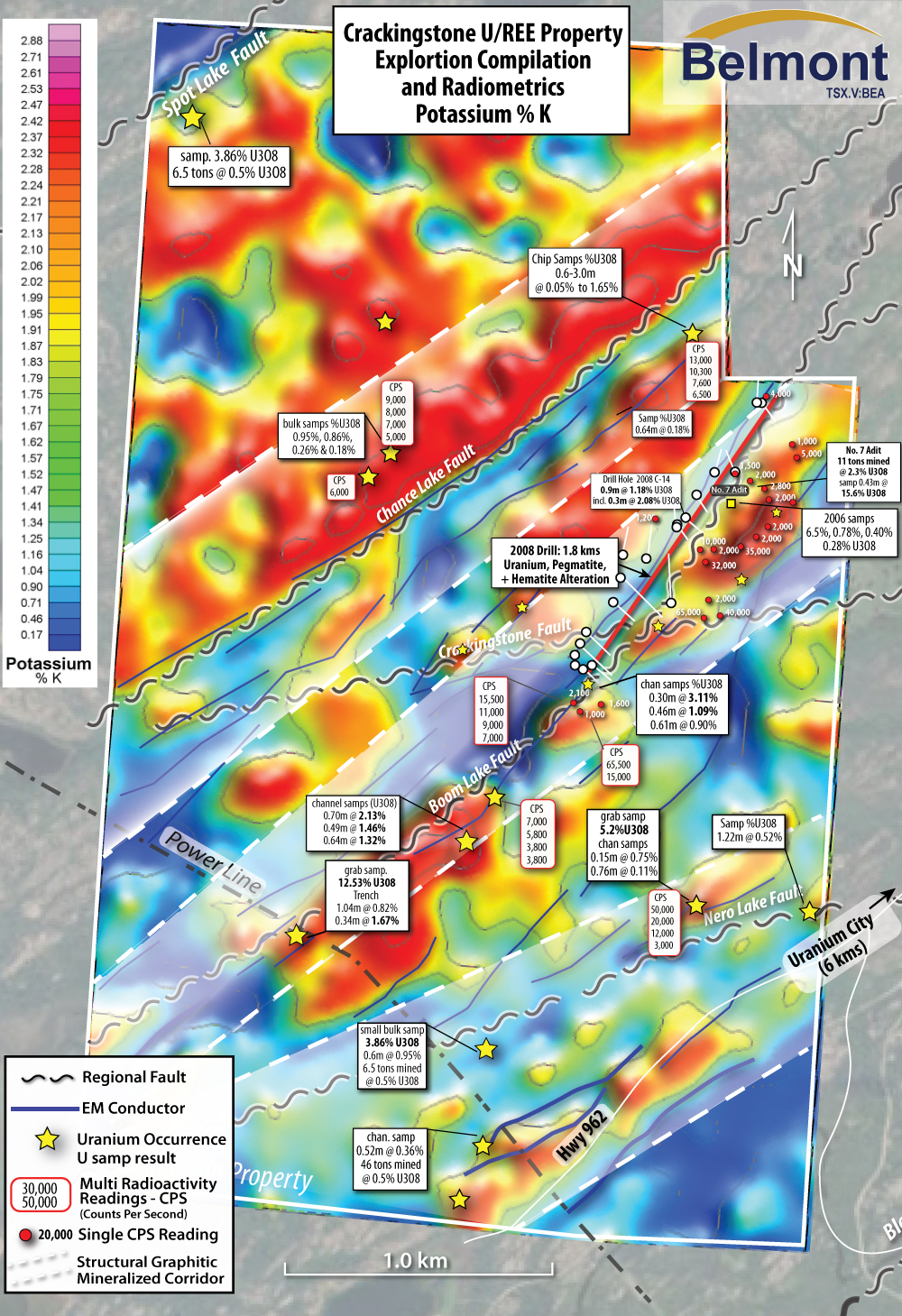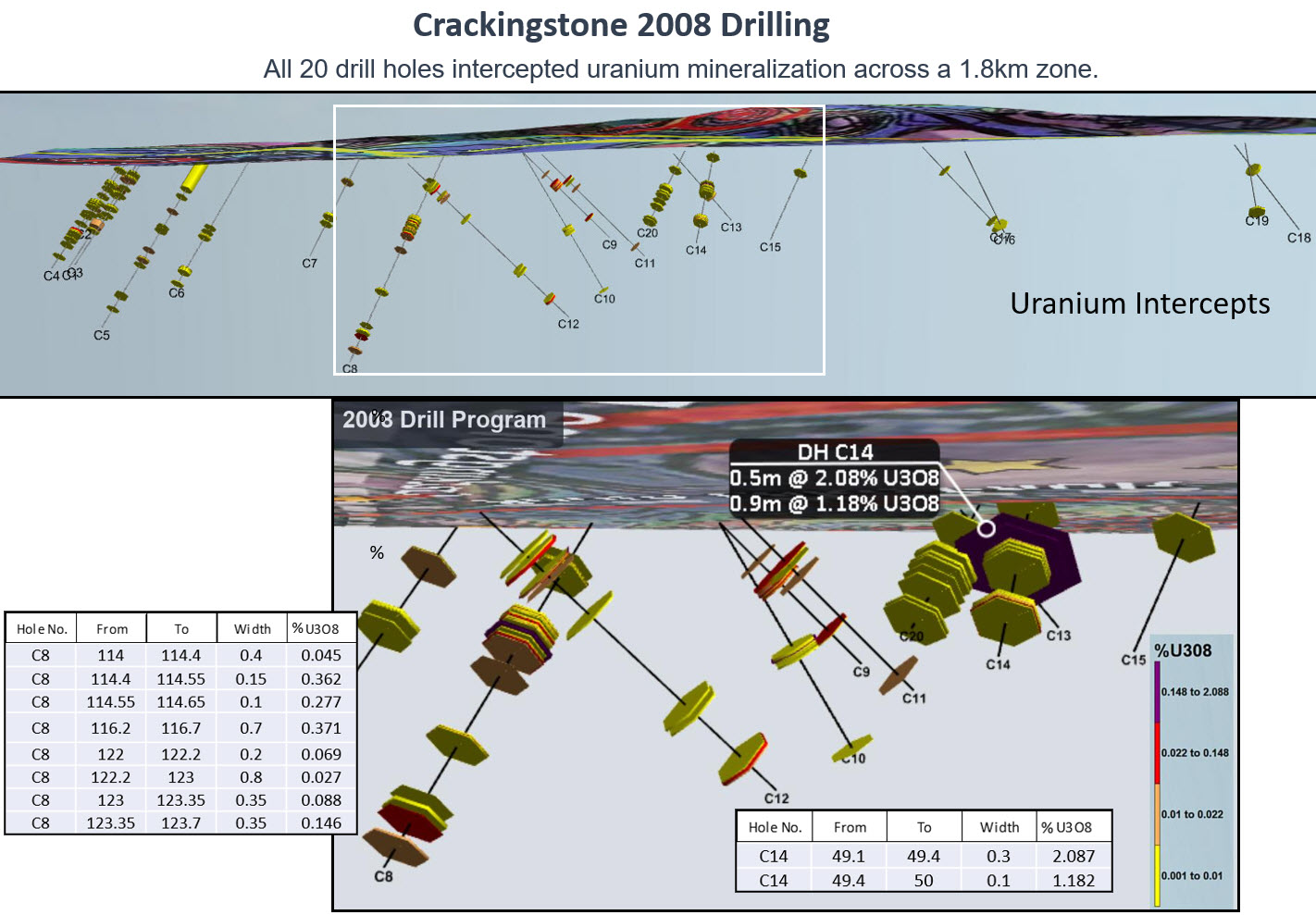Crackingstone
Uranium/Rare Earths
Uranium mineralization and the host environment for Rare Earths-bearing pegmatites,
the Crackingstone project is a unique dual-commodity opportunity
in the prolific Beaverlodge camp, northern Saskatchewan.
Being situated in the Beaverlodge district anchors Crackingstone in a world-class uranium setting, providing both geological credibility and investor recognition — while its added REE potential makes it stand out from typical Beaverlodge prospects.
The Crackingstone property covers 5 kms of the Black Bay Shear Zone.
The Black Bay Shear Zone is part of the larger Beaverlodge uranium district, which historically produced over 70 million pounds of U3O8 between 1953 and 1982, highlighting the regional potential
The Black Bay Shear Zone’s influence on the Crackingstone project is significant, providing the structural framework, historical context, and geological indicators that make this project highly prospective for uranium exploration and potential discovery.
Crackingstone’s Structural Corridors
Three mineralized structural corridors at Crackingstone are the backbone of its exploration potential. They provide the plumbing system for uranium mineralization and the host environment for Rare Earths (REE)-bearing pegmatites, making the project a unique dual-commodity opportunity in the Beaverlodge camp.
- Multiple Corridors: Three parallel structural/mineralized corridors with coincident EM conductors, radiometric highs, and known uranium showings = several drill-ready targets.
- Dual Commodity Relevance: Structural corridors not only host uranium but also localize thorium and REE bearing pegmatites — e.g., large thorium anomaly along Chance Lake Fault.
- Proven Mineralization: 2008 drilling confirmed uranium along 1.8 km of one corridor, with all 20 holes intersecting mineralization. Open along strike and depth.
• District Analogy: Structural setting comparable to major Beaverlodge deposits (e.g., Gunnar, Fay-Ace), where shears localized high-grade uranium.
The Uranium Thesis
- 5 km strike length along the Black Bay Shear Zone, one of the most uranium-fertile structures in the Beaverlodge camp.
- 1.8 km mineralized corridor already drilled – uranium hit in all 20 drill holes (2008 program).
- Highlight intersections: up to 2.09% U₃O₈ over 0.3 m (within 1.18% over 0.9 m).
- Multiple surface showings grading up to 12.53% U₃O₈, plus historic shipments (~2.3% U₃O₈).
- Strong hematite alteration and coincident radiometric/structural/EM anomalies point to a robust, district-scale system.
- Ground scintillometer surveys that return readings in the thousands of cps (well above background) are considered strong evidence of uranium- or thorium-bearing mineralization along the shears and pegmatites.
The Rare Earths Thesis
- Thorium-rich pegmatites mapped and drilled over 1.8 km.
- Chip/channel samples ran 1,250–1,424 ppm TREO at surface.
- Major thorium anomaly spatially linked to the Chance Lake Fault — a prime structural control.
- 2008 drill core intersected thick pegmatites that were never assayed for REEs.
- Provides dual commodity exposure (Uranium + REEs), rare in Beaverlodge.
Potassium
“Airborne radiometric data over the Crackingstone property show coincident thorium and potassium anomalies.
Elevated potassium is interpreted to reflect potassic alteration associated with shear-hosted uranium mineralization, while thorium enrichment is spatially associated with pegmatitic phases along the Chance Lake Fault.
The overlap of these anomalies supports the interpretation that both structurally controlled uranium and thorium-bearing, REE-enriched pegmatites occur within the property , underscoring the project’s unique dual-commodity potential.”
Electro Magnetic (EM) Conductors
“Airborne EM surveys on the Crackingstone property have outlined multiple conductors coincident with major shear zones and radiometric anomalies. These conductors likely reflect graphitic and sulphide-rich fault zones, the same structures that host many Beaverlodge uranium deposits. Their coincidence with uranium-thorium radiometric highs significantly strengthens the case for fertile, mineralized shear systems on the property.”
Criteria for high-priority drill targets
Quality drill targets at Crackingstone are defined where structural corridors intersect with EM conductors and radiometric highs, supported by scintillometer anomalies and surface sampling. The best targets will not only extend known uranium mineralization but also test the REE-thorium potential in pegmatite-rich zones.
1. Structural Criteria
-
Proximity to major shears: Priority on targets along the Black Bay Shear Zone and the Chance Lake Fault, both proven uranium-bearing structures in Beaverlodge.
-
Cross-cutting features: Intersections of secondary faults with the main shear corridors — often the most fertile locations for high-grade pods.
-
Corridor continuity: Focus on the three known mineralized corridors, especially areas extending beyond the 1.8 km drilled trend.
2. Geophysical Criteria
-
EM conductors: Drill along conductors coincident with shears, as they indicate graphitic/sulphidic zones that are prime uranium traps.
-
Radiometric anomalies: Prioritize overlapping U–Th–K highs, especially where they align with EM conductors and faults.
-
Stacked anomalies: The highest priority targets will be where multiple datasets converge (structure + EM + radiometric).
3. Geochemical & Surface Criteria
-
Historic showings: Areas with grab samples up to 12.53% U₃O₈ and historic shipments (~2.3% U₃O₈) are obvious high-priority drill sites.
-
Scintillometer hot spots: Ground CPS readings significantly above background (>1,000 cps) are strong indicators of uranium/thorium mineralization at surface.
-
Chip/channel REE anomalies: Pegmatites with 1,250–1,424 ppm TREO values, particularly where they coincide with thorium anomalies on the Chance Lake Fault, add REE upside.
4. Drilling & Exploration Strategy
-
Step-outs on known mineralized corridor: Extend beyond the 1.8 km of uranium already drilled to test for continuity along strike and at depth.
-
Untested corridors: Test EM + radiometric + structural corridors that have not been drilled — especially in the northern section with the thorium anomaly.
-
Dual commodity targeting: Prioritize zones that offer both uranium and REE potential (uranium-bearing shears adjacent to REE-bearing pegmatites).
Compilation over Uranium
Compilation over Thorium
Compilation over Potassium
2008 Drill Program
The 2008 drilling results have several important implications for the next exploration program
- Confirmed Mineralization: The 2008 program successfully intercepted uranium mineralization across all 20 drill holes, confirming the presence of uranium in the project area. This provides a strong foundation for further exploration.
- High-Grade Potential: Significant high-grade intercepts were encountered, including 2.09% U3O8 over 0.3 m within a broader zone of 1.18% U3O8 over 0.9 m. This demonstrates the potential for high-grade uranium deposits on the property.
- Mineralized Trend: The drilling defined a 1,800-meter strike length of near-surface uranium mineralization associated with pegmatite and hematitic alteration along the Boom Lake fault. This extensive mineralized trend provides a clear target for follow-up exploration.
- Geological Indicators: The program intercepted a 1.8-kilometer pegmatite dyke and extensive hematite alteration. Both pegmatites and hematite alteration are commonly associated with uranium mineralization in the Athabasca basin, indicating favorable geological conditions for uranium deposition.
- Structural Control: The results confirmed the importance of structural features, particularly the intersection of the Boom Lake and Crackingstone faults, in controlling uranium mineralization. This guides the targeting strategy for the current exploration program.
Crackingstone 2008 drill section – Uranium
Crackingstone 2008 drill section – Hematite
Crackingstone 2008 drill section – Pegmatite
- Exploration Model Validation: The 2008 results validated the exploration methodology of targeting structural intersections and conductive zones, which is being applied in the current program.
- Open Mineralization: The mineralization remains open in multiple directions, suggesting potential for expansion of known uranium zones.
- Drilling Strategy: The success of the 2008 program informs the current drilling strategy, with plans for a 40-hole, 10,000-meter program over two years to test the most promising targets.
- Exploration Potential: The positive results from 2008 underscore the overall exploration potential of the Crackingstone project, justifying Belmont’s renewed focus on the property in the current uranium market.
